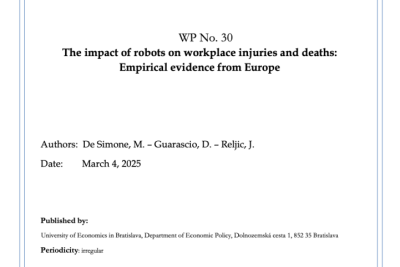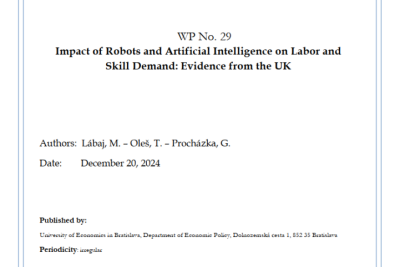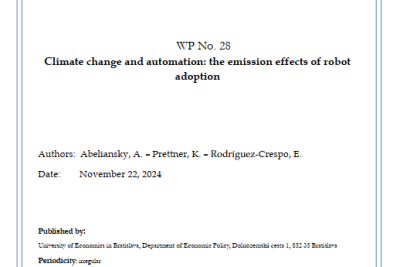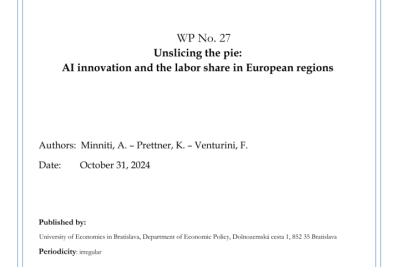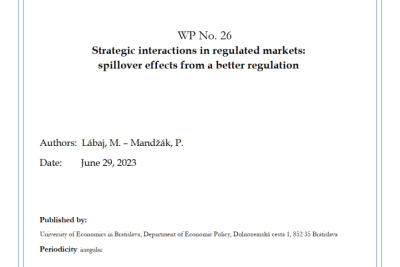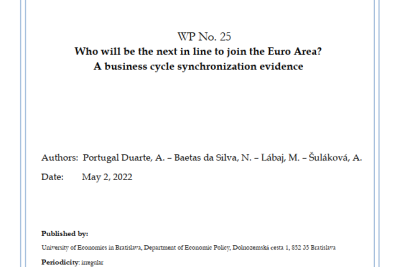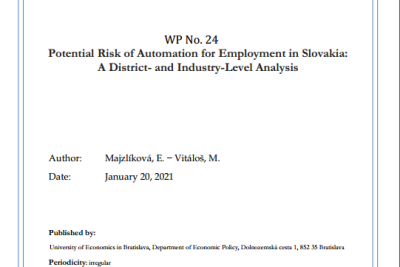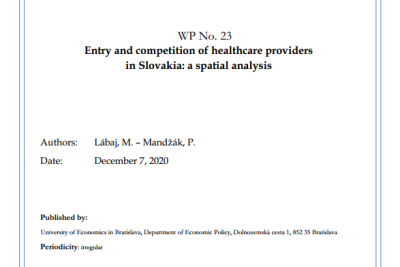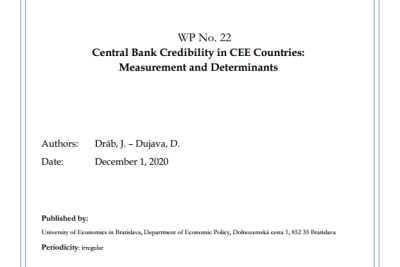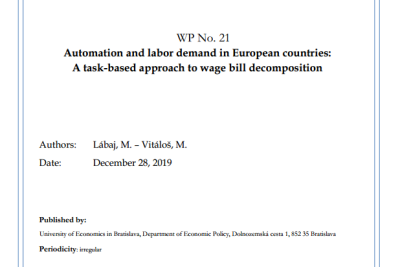Abstract
This paper examines the impact of robotisation on workplace safety in EU manufacturing sectors between 2011 and 2019. To address endogeneity concerns, we employ an instrumental variable approach and find that robot adoption reduces both injuries and fatalities. Specifically, a 10% increase in robot adoption is associated with a 0.066% reduction in fatalities and a 1.96% decrease in injuries. Our findings highlight the context-dependent nature of these effects. The safety benefits of robotisation materialise only in high-tech sectors and in countries where industrial relations provide strong worker protections. In contrast, in traditional industries and countries with weaker institutional frameworks, these benefits remain largely unrealised. The results are robust to several sensitivity tests.
Abstract
Over the past four decades, automation technologies have replaced routine tasks performed by medium-skilled workers, and contributed to increased labor market polarization. With the advent of artificial intelligence, this dynamic may have shifted, extending task substitution to non-routine tasks performed by high-skilled workers. Using textual analysis and descriptions of technology found in patent texts, we construct novel occupational exposures to robot and artificial intelligence technologies. These occupational exposures are then used to analyze changes in labor and skill demand over the last decade in the United Kingdom. We find that the middle part of the income distribution is primarily exposed to robot technology, while exposure to artificial intelligence increases monotonically across income percentiles. Second, we find that exposure to robots is strongest among high school dropouts and declines monotonically with education, while artificial intelligence automation has a limited impact on the same workers, with a pronounced exposure among college graduates. Third, our findings suggest asymmetric effects of automation technologies across skill groups. Robot automation reduces demand for low-skilled workers, while AI technology shifts demand away from high-skilled workers, with the direct effects consistently negative despite the presence of several compensating mechanisms. Finally, a joint estimation of the effects of robot and AI automation shows that robot automation is positively associated with an increase in demand for skilled workers, while AI automation is weakly associated with a decrease in demand for skilled workers. These patterns indicate structural changes in the labor market, with important implications for wage inequality and the future of work.
Abstract
What are the environmental impacts of the increasing use of automation technologies? To answer this question, we propose a model of production in the age of automation that incorporates emission externalities. We derive a threshold condition subject to which the use of industrial robots affects emissions. This model leads to three testable predictions, i) the use of industrial robots causes higher emissions on average, ii) with increasing efficiency of industrial robots, the effect becomes weaker and could turn negative, and iii) in countries in which electricity is predominantly produced using (clean) renewable energy, industrial robot use has the potential of decreasing emissions. Empirically, we find support for the theoretical hypotheses implying that the effect of automation on emissions is non-linear or moderated by other variables.
Abstract
We study how the development of Artificial Intelligence (AI) influences the distribution of income between capital and labor and how this, in turn, exacerbates geographic income inequality. To investigate this issue, we first build a theoretical framework and then analyze data from European regions dating back to 2000. We find that for every doubling of regional AI innovation, there is a 0.7% to 1.6% decline in the labor share, which may have decreased by between 0.20 and 0.46 percentage points from a mean of 52% due solely to AI. This new technology is particularly detrimental to high-skill and medium-skill labor. The impact on income distribution is driven by worsening wage and employment conditions for high-skill labor, and by wage compression for medium- and low-skill labor. The effect of AI is not driven by other factors affecting regional development in Europe, nor by the concentration process in the AI market.
Abstract
Usually, health policy makers face a trade-off between benefits and costs from healthcare markets regulation and deregulation. We argue that these markets and policy reforms should not be studied in isolation as the effects from regulation in one market spillover to other markets. In particular, we study entry decisions and strategic interactions between general practitioners, pediatricians, and pharmacies. We show that a better regulation and accessibility of one profession allow policy makers to relax spatial restrictions and regulations of other healthcare professionals. We document that these spillover effects could be sizeable as the entry thresholds for pharmacies to enter the market decrease by 70 % with the presence of a general practitioner. Our counterfactual analysis suggests that a better coverage of GPs would improve spatial accessibility of pharmaceutical services and lead to an entry of new pharmacies in currently unattractive markets, mostly in rural areas.
Abstract
The aim of this paper is to investigate business cycle synchronization between seven candidate countries to the Euro Area (EA) – Bulgaria, Czech Republic, Croatia, Hungary, Poland, Romania and Sweden – and the Euro Area (EA-12/EA-19), France and Germany. The Hodrick-Prescott filter is used to decompose the real Gross Domestic Product into trend and cyclical components for the period 1995Q1-2019Q4. The results point to the existence of a strong business cycle synchronization between Sweden and the Euro Area, Germany, and France. The second highest correlation was observed for the Czech Republic followed by Hungary, Poland and Croatia. In contrast, Bulgaria and Romania show the weakest business cycle synchronization with both the Euro Area and the core economies. We conclude that Sweden is the most prepared country to be the next passenger in the single currency train from the perspective of business cycle synchronization.
Abstract
The aim of this paper is to examine the potential impacts of automation and digitalisation on the Slovak labour market, which, according to several studies, belongs to a group of countries with the highest risk. To quantify the share of employment at a high risk of automation, we use detailed employment data and automatability estimates (or substitutional potentials) for individual occupations according to three different methodologies: by Frey and Osborne (2013), Dengler and Matthes (2018), and Mihaylov and Tijdens (2019). In 2019, depending on the approach taken, the share of employment in Slovakia at a high risk of automation ranged from about 20 to 47%. Districts at the highest risk of automation include Kysucké Nové Mesto, Bytča, Myjava, Skalica and Krupina, while districts with the lowest share of employment at risk are Svidník, Levoča, Ružomberok, Košice I and Trebišov. A key point is that technological progress is not likely to increase the existing regional differences in Slovakia or have a greater impact on districts with high unemployment. Other findings show that employees with a lower income face a higher risk of losing their job as a result of technological progress. Industries with the largest share of employment at a very high risk include many manufacturing industries, as well as wholesale and retail trade. In terms of occupations, mechanical machinery assemblers and electrical equipment assemblers face the highest risk. Regarding trade, occupations potentially facing a high risk include shop sales assistants, cashiers, ticket clerks, commercial sales representatives, and stock clerks.
Abstract
We study the relationship between market size and a number of firms in several healthcare professions in Slovakia to provide a new evidence about
their entry decisions and a toughness of competition in the market. The size of a local market to support the entry of the first general practitioner
is estimated to 1400 inhabitants. It equals 1700 inhabitants for the first pharmacy to enter, and 2300 for pediatricians. The population has to more
than double for the second professional to enter. To support the second firm, the population per firm in the market has to increase by 30 % for pharmacies, by 25 % for general practitioners, and by almost 40 % for pediatricians. However, after the entry of the second firm, the intensity
of competition does not change, except for pediatricians. The results are robust to spatial interactions taken into account. However, our estimates of
spatial interactions show negative (but decreasing) spatial spillover effects for pharmacies, general practitioners, and dentists between 1995 and 2010. In
this period, competitive effects prevailed and outweighed demand spillovers. We document that demand effect continued to grow since 2010 and in 2017
outweighed the competition effect for pharmacies.
Abstract
We use three different indicators based on inflation expectations to measure central bank credibility in 9 countries in Central and Eastern Europe. We quantify credibility using differences between official inflation targets and inflation expectations as well as differences between inflation expectations and implicit targets based on estimation of the Taylor rule. Determinants of central bank credibility are investigated using pooled OLS. According to our results, stable and low inflation and sound public finances are conductive to central bank credibility. We show that our results are in line with survey-based measures of trust in local currency.
Abstract
To understand the effects of automation and other types of technological changes on European labor demand, we use a framework and empirical decomposition of observed changes in the total wage bill in the economy developed by Acemoglu and Restrepo (2019). The decomposition is derived from a task-based model that allows us to study the effects of different technologies on labor demand. At the center of the framework is the task content of production|measuring the allocation of tasks to factors of production. Automation, by creating a displacement effect, shifts the task content of production against labor, while the introduction of new tasks in which labor has a comparative advantage improves it via the reinstatement effect. Overall effects are country-time specific and call for an empirical exploration. We apply the decomposition to 15 European countries with good data coverage in EU KLEMS database.
Strategic partner
Main Partners
Partners

